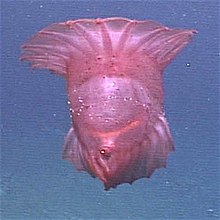| Enypniastes eximia | |
|---|---|

| |
| Scientific classification | |
| Domain: | Eukaryota |
| Kingdom: | Animalia |
| Phylum: | Echinodermata |
| Class: | Holothuroidea |
| Order: | Elasipodida |
| Family: | Pelagothuriidae |
| Genus: | Enypniastes |
| Species: | E. eximia
|
| Binomial name | |
| Enypniastes eximia | |
| Synonyms[2] | |
|
List (Genus): (Species):
| |
Enypniastes is a genus of deep-sea sea cucumber. It is monotypic, being represented by the single species Enypniastes eximia. Due to its unique appearance, the species has been dubbed the headless chicken fish, headless chicken monster, and the Spanish dancer.[3][4] It is also known as the swimming sea cucumber, and some are called the pink see-through fantasia.[5]
- ^ Théel, Hjalmar (1882). Report on the Holothuroidea dredged by H.M.S. 'Challenger' during the years 1873-76. Part i. Report on the Scientific Results of the Voyage of H.M.S. Challenger during the years 1873–1876. Zoology. 4 (part 13): i-ix, 1–176, pl. 1-46., available online at http://19thcenturyscience.org/HMSC/HMSC-Reports/Zool-13/htm/doc.html
- ^ WoRMS (2020). Enypniastes Théel, 1882. Accessed at: http://www.marinespecies.org/aphia.php?p=taxdetails&id=123526 on 2020-03-28
- ^ Bright, Michael (2013). The Shark that Walks on Land: And Other Strange but True Tales of Mysterious Sea Creatures. Biteback Publishing. ISBN 9781849546645.
- ^ Clemens, Danny (October 21, 2018). "'Headless chicken monster' spotted swimming in Antarctic Ocean". KABC-TV. Retrieved October 21, 2018.
- ^ Albeck-Ripka, Livia (October 22, 2018). "'Headless Chicken Monster' Spotted in the Deep Sea". The New York Times. Retrieved October 23, 2018.